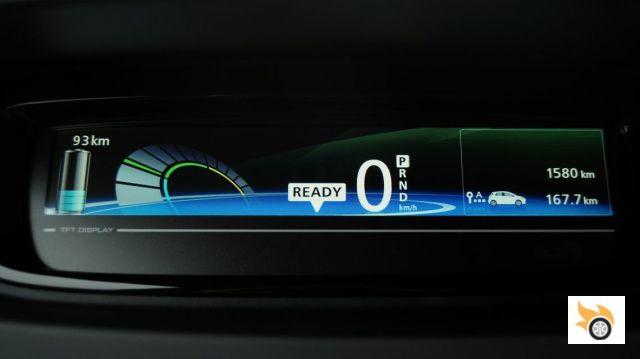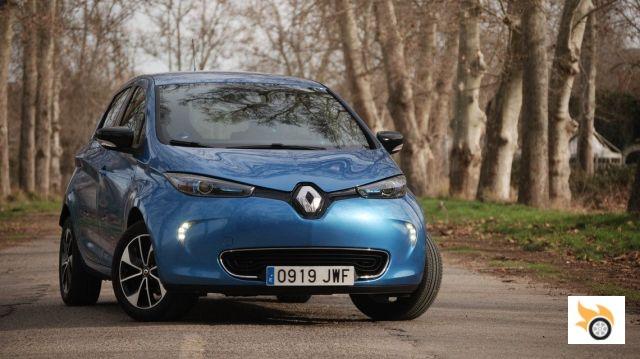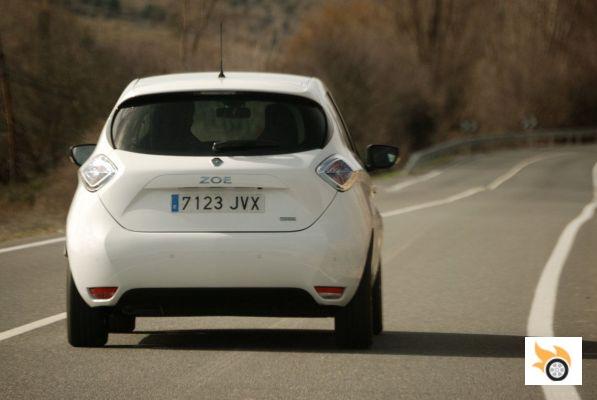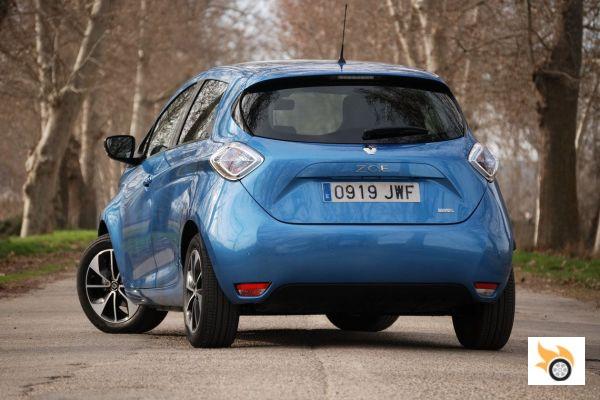According to the NEDC homologation, it is capable of 400 kilometers in mixed cycle, but there must be very favorable conditions, such as having dinner with Angelina Jolie and she pays the bill. In a more realistic use we are talking about 300 kilometers of range without doing strange things, and from Renault admit that it can go down to 200 kilometers in difficult conditions (very cold, highway at 120 km / h or more, improper use of the brake ...) It will be half, but it is already a very decent range! By the way, Renault has made it clear that it does not buy cobalt for its batteries from countries in conflict.
Right now, and until the Opel Ampera-e arrives, the ZOE is the generalist electric car with the longest range on the market, and is even competitive with the BMW i3 REX with 33 kWh batteries (using gasoline and with limited performance). We checked it in a very varied route along the Community of Madrid, with all kinds of roads, trying to achieve a distance + remaining range that added up to 300 km. But we did it in a different way, driving as if the range didn't matter, as it was going to be enough. In other words, I simulated a totally realistic driving, not oriented to maximize the load. My presentation partner did the same.
All images are of ZOE in Intens (intermediate) trim level.
The Renault ZOE z.e. 40 is distinguished from any other ZOE simply by a badge on the back. There's no way to tell it has more capacity besides looking at the number plate, as the first units have no more than 22 kWh. The rest of the car is exactly the same, although it is a bit heavier, 15 kg heavier according to the manufacturer. The secret is in the internal structure of the cells, which has been optimized while maintaining the volume, so more kWh fit in the same space. It maintains 192 cells divided into 12 modules. According to Renault, performance, reliability and passive safety are maintained.
It is powered by the R90/Q90 engine (formerly known as R240), which is entirely Renault and not from an external supplier, and achieves 30 km of range compared to the original Continental engine. It delivers 225 Nm up to 3,000 rpm and 92 hp between 3,000 and 5,000 rpm. The latter should not worry us because there is no "gearbox", it is a fixed ratio with reduction, nor is there a rev counter. In fact, the instrumentation is 100% digital. In addition to the speed and data from the on-board computer, it indicates our energy use graphically. There are three modes of representation, which alternate with a button in the upper right corner.
I find the gear knob too bulky for its real purpose.
For regular commuting, and in the spirit of maximizing the charge, the ECO button limits the speed to 90 km/h. This is perfect for those who regularly drive on the M-30 or inside the M-40 in Madrid. If more speed is needed, just press the accelerator pedal fully down, as if you were using the cruise control. The button that toggles between the limiter and the cruise control is just as badly placed as in the Clio, next to the gearshift.
Driving the ZOE gives the same sensation as any electric car: uninterrupted and linear acceleration, very intense below 90 km/h - it does 0-50 km/h in 4 seconds - and then sluggish, very quiet and very pleasant. At low speed it emits a very faint sound that warns pedestrians of the car's presence, but it sounds like the future. In addition, the electric motor is not 100% silent, it has a very characteristic sound when accelerating. The noise of a conventional car is not missed, and if that's the case, the R-Link can emulate the sound of several cars and a motorcycle, although it's all very artificial.
In the specific case of the ZOE, a slightly higher driving position is noticeable, as the passengers literally sit on top of the batteries, which are located under the floor. On the other hand, the dashboard reflects a lot of light, as you can see in the picture, for people who, like me, are very sensitive to light, it can be a bit uncomfortable. The qualities and finishes are similar to those of the Clio, although this one will age better, the engine doesn't transmit any vibration, nor will it get worse with time.
At 75 km/h the noise level is only 65 decibels.
The suspension is comfortable, I would say in all circumstances. At typical highway speeds there is an aerodynamic hiss at the B-pillar that goes unnoticed if the stereo is on. In general, the car feels more comfortable between 90 and 120 km / h for sound, power consumption and so on. It can go up to 135 km / h, it is limited from the factory. I think we will all agree that it is a more than acceptable trot, in the electric high speed devours batteries and collapses autonomy.

The new ZOE comes in two body colours, Intense Red and Titanium Grey.
The test route included two stops, in which Renault staff did not make any recharging. The sum of autonomy and travel did not exceed 300 kilometers at any time, but did not fall below 260 kilometers total. It must be said in defense of the car that an outside temperature of about 5 degrees is not exactly the most optimal for charging to the maximum, then the useful capacity was less than 41 kWh.
According to Renault, the batteries are "conditioned" and operate between 15 and 28 degrees in "all circumstances". Experience in Nordic countries has helped engineers optimize the batteries to work in very cold or very hot weather, as that greatly affects their performance. On a day like this it was not an option to turn off the air conditioning, which remained in automatic mode at 22 degrees, and part of the journey was not necessary because there was enough sunlight.
The ZOE has a quiet ride, but it feels settled in the curves as it has a lot of weight in a low area, then its center of gravity is lower. A car with higher suspension, like the Captur, doesn't offer the same sensation as it has a higher centre of gravity. It's physics, gentlemen. It would be a very pleasant car to travel in if it weren't for the thick front seats, which limit the habitability of the rear seats in terms of knee room. If someone very tall is in the front, it's going to be noticed in the back.

Back at the Renault Spain headquarters we had completed between me and another driver 167 kilometers, with additional range for another 93 km. The press guys said that it was a very good record, although we were not looking for a low fuel consumption. Something has to be noticed in the habit of driving a hybrid, because 4 kWh were regenerated taking good advantage of the inertias, but, I insist, at completely normal speeds. The average speed of 50 km/h is low, as most of the trip was on local roads and towns. Consumption was 15.4 kWh/100 km, which is quite normal for an electric car that is driven without "consideration".
What's more, we spent a total of 25 kWh, so, if we were to spin a little thin, we could have managed to cover that distance with the 22 kWh ZOE. Without going over 90 km/h and limiting the use of the air conditioning a bit, it's perfectly possible. Renault relegates the lower capacity batteries to the basic model, the Entry, from 16,625 euros (rental batteries) or 24,125 euros (owned batteries).
Renault calculates that, considering all costs, the ZOE comes out 20% cheaper per kilometer than a Clio.
That's another, Renault already allows you to buy the batteries and go from renting. That comes at a price, 7,500 euros for 22 kWh. The 41 kWh model starts at 19,125 euros (rental) or 26,625 euros (ownership), with the same equipment. Here the price difference is the same, 7,500 euros. The rental varies depending on the mileage, although there is a mode of 119 euros per month in which you can do all the kilometers you want. It is also possible to change the batteries and put the higher capacity ones in a used ZOE, 3,500 euros is worth the operation, and half a day in time. Whether it's worth it or not, it's up to each one.
A look at the immediate future of the ZOE: more connectivity
The manufacturer is finalizing 100% useful technologies for this model, which can make life much easier for its owners, thanks to Internet connectivity:
- Z.E. trip: it's an R-Link app that allows you to plan your journeys taking into account charging points, their availability and even plug type. It is a system similar to Nissan's Carwings. It is useful for long trips with less worries, such as knowing the fast chargers on a route. It is already available in Germany, soon to arrive in France, United Kingdom, Belgium, Austria, Switzerland, Holland, Norway and Sweden. Spain will follow at a later date.
- Z.E. pass: is a payment system that will be implemented to be able to use any charger without being subscribed to the charge manager, useful especially when traveling. Payment can be made by RFID card or through a specific application on the mobile phone. No, electric car chargers are not "slot machines", they do not accept cash. It already works in Germany, and is being implemented in France, United Kingdom, Belgium, Austria, Switzerland, Holland, Norway and Sweden. In Spain, who knows when it will arrive.
- Mobile application: it will be ready during this semester. The car will be able to provide information such as charging status, latest consumption and journeys made, the possibility of pre-conditioning the cabin (heating or cooling the car with electricity from the socket), get alerts from the diagnostic system, door to door navigation (where the car can not follow, gives directions to follow on foot) and a very long etcetera.
In electric cars connectivity is especially useful, because it allows to know the state of charge, for example: "available autonomy for 100 kilometers, remaining recharge time 3 hours and 15 minutes". Since the buyer of an electric car is usually an informed and tech-savvy person, these functionalities are very convenient and have a high potential for use.

The ZOE range in Spain
In the access step are the ZOE Entry with 22 kWh batteries and the most modest equipment. They are quickly distinguished by the 15-inch steel wheels (optional 16″ wheels), integrated charger 22 kW, R-Link with browser (optional) and sound system, automatic climate control, electrically adjustable mirrors, voice control, speed limiter regulator, etc..
The Entry and Life only have two rear headrests and the third is not available.
With the 41 kWh batteries we have the Life, which has exactly the same equipment as the Entry. The Intens has more things (like the one in the pictures), like light and rain sensors, 16″ wheels, electric rear windows, rear parking sensor, hands-free access and start card, and more optional equipment (17″ wheels, central headrest, rear parking camera...). The Intens can be charged at 43 kW of power, i.e. in half the time with a fast charge point.
The top of the range is the BOSE, with heated leather seats, rear view camera, a slightly more detailed interior, bespoke acoustic installation by BOSE, third rear headrest and, optionally, the 17″ wheels. You can also opt for an additional colour, Rhodium Grey. In France it will be known as Edition One. Whatever it's called, it's a limited series.

Questions and answers
- Who usually buys a ZOE? We are talking about 436 units in Spain in 2016, 91% had another car. They are usually people with a good income (more than 60,000 euros per year), almost 50 years old, mostly men. They have not wanted to get involved with sales figures or with respect to which version will sell better, the normal autonomy and doubled autonomy. The cost of installing the charging wall is partially covered by the manufacturer, within the price of the car.
- How long do the batteries last? Those who rent them don't have to worry about that, because if they need to be changed, it is already included in the price. Those who own them will have to worry about that. Renault gives eight years or 160,000 kilometers for the batteries, they estimate their life and that of the car in "more than 10 years". By the way, Renault as a manufacturer is committed to serve any spare part 10 years after the last registration, being the legal minimum of five years.
- Are there any subsidies? Not at the state level at the moment. While a new aid is approved Renault is offering a promotional discount of 5,500 euros which is already included in the prices supplied. However, having an electric car has a number of obvious advantages, especially in Madrid, where half of Spain's electric cars are being registered. They can circulate when the city is closed to traffic, they can park in the SER zone for free (you have to request it, it is not automatic), and circulate on the VAO bus on the A-6 even if there is only one passenger.
- How long does it take to recharge? Renault claims that the recharging speed is the same, which is a dialectical trap. The electrons enter at the same speed, charging up to 43 kW at fast charging points. The difference is that it takes longer to fill up, the capacity has almost doubled. If we compare a one-litre bottle and a two-litre bottle, at the same filling speed they will not fill at the same time. Logical, isn't it? The fastest range gain is 120 kilometres in half an hour. A 10 amp household socket charges at a rate of about 2.2 kW every hour, so 22 kW can be recharged in 10 hours. Obviously not all ZOE users leave the batteries at 0% every day, this is an extreme case.
- Is a domestic fast charge point feasible? No. Its cost would exceed 40,000 euros, and the fixed term of power, whether it is used or not, is 5,000 euros per year. If this is already a high cost for a city council or a company, for a private individual, let's not even talk about it. Of course, you can easily charge at 16 amps at home, that is, 3.68 kW every hour ignoring losses, without having to hire more than 5.3 kW of power (yes, plugging in a few more things).
- Can I install a charging point in a communal garage? Yes, after the reform of the LPH you can do it without the permission of the community of neighbours, you only have to inform before, and pay 100% of the cost of the installation. If the consumption cannot be priced individually, it is necessary to reach an agreement with the community to pay the extra consumption of electricity attributable to the interested party.

If there are more questions, I will answer them in the comments, but these are the most typical ones.
























